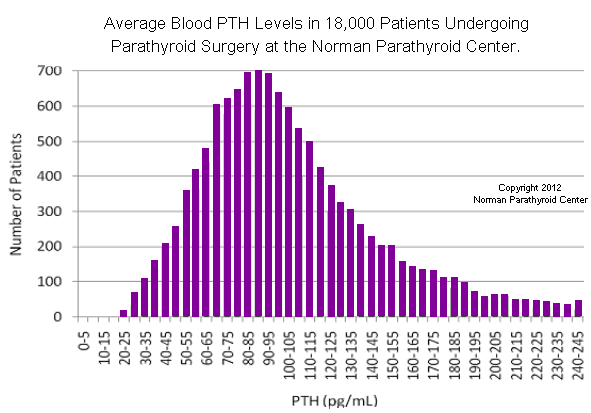Parathyroid Disease (Hyperparathyroidism): Causes, Symptoms & Cure
Parathyroid disease, also known as hyperparathyroidism, occurs when one or more of the parathyroid glands become overactive and produce too much parathyroid hormone (PTH). This causes calcium levels in the blood to rise and leads to a wide range of symptoms of hyperparathyroidism such as fatigue, bone pain, and brain fog.
What Is Hyperparathyroidism (Parathyroid Disease)?
Hyperparathyroidism is a condition in which one or more parathyroid glands become overactive and produce excess parathyroid hormone (PTH), leading to high calcium levels in the blood and potential damage to bones, kidneys, and other organs.
Quick Facts About Hyperparathyroidism
- Most cases are caused by a benign parathyroid tumor (adenoma).
- High blood calcium is the hallmark; PTH may be high or “inappropriately normal.”
- Surgery is the only cure; most patients feel better within days.
- Untreated high calcium leads to bone loss, kidney stones, and heart risks.
- Diagnosis relies on calcium + PTH blood tests and expert evaluation.
What Causes Hyperparathyroidism (High Calcium)?
Hyperparathyroidism is almost always caused by a benign parathyroid tumor (adenoma) that makes too much parathyroid hormone (PTH). Excess PTH pulls calcium from the bones into the bloodstream, raising blood calcium and damaging bones, kidneys, and other tissues.
In parathyroid disease, one of the four parathyroid glands grows into a benign tumor that continuously produces PTH and ignores normal “stop” signals. Even when calcium is already high, the abnormal gland keeps making hormone. This is a hormone problem caused by a benign tumor—not a cancer—though prolonged high calcium increases other health risks. The short video below shows how the tumor develops, disrupts calcium balance, and why removing it cures the disease.
Watch a video at https://www.youtube.com/embed/sD9st1ZPFrQ
Sometimes hyperparathyroidism makes people miserable within the first year or two of having high blood calcium (see our page on symptoms of hyperparathyroidism). Other times it can go 10 years without causing too much problems other than fatigue, bad memory, kidney stones, and osteoporosis. But make no mistake about it, parathyroid disease does kill people. It just takes 20 or so years to do so.
The most common cause of excess parathyroid hormone production, what we call primary hyperparathyroidism or parathyroid disease, is the growth of a benign tumor in one of the four parathyroid glands. This enlargement is called a parathyroid adenoma and accounts for roughly 70 percent of all cases. The remaining 30 percent of patients have more than one abnormal gland.
A parathyroid adenoma is almost never cancer. Nearly 100 percent are benign, but that does not mean they are harmless. The tumor continuously releases parathyroid hormone (PTH), which raises calcium in the blood and slowly damages bones, kidneys, and other tissues. Normal parathyroid glands are each about the size of a grain of rice. A tumor, by contrast, is usually the size of an olive or a small grape. Removing that single enlarged gland almost always cures the problem.
 Typical Parathyroid Adenoma Causing Hyperparathyroidism
Typical Parathyroid Adenoma Causing Hyperparathyroidism
About 30 percent of patients have more than one parathyroid tumor, which is why an experienced surgeon examines all four glands during surgery to be sure the others are normal. People do perfectly well with fewer than four healthy glands.
The photograph shows a typical parathyroid adenoma, a common cause of hyperparathyroidism and secondary hyperparathyroidism. It represents the average size, shape, and color of what we find during surgery. One normal cell inside the gland went out of control, dividing again and again until it formed this tumor. It will keep growing and producing hormone until it is removed. The excess PTH pulls calcium out of the bones and sends it into the bloodstream, making the calcium level too high. You can view more examples on our page of parathyroid tumor photographs to see what these small but powerful tumors look like.
What Is Secondary Hyperparathyroidism?
Secondary hyperparathyroidism occurs when another condition—most often chronic kidney disease or severe vitamin D deficiency—causes the parathyroid glands to become overactive and produce too much parathyroid hormone (PTH). The body’s calcium balance is disrupted as the glands try to compensate for low calcium or vitamin D levels.
Treatment focuses on correcting the underlying cause, such as improving kidney function or restoring vitamin D levels. However, some patients still benefit from parathyroid surgery when the glands remain enlarged and continue to overproduce hormone despite medical therapy.
Where Do Parathyroid Tumors Come From?
This is a great question, and the answer is quite simple. In most cases, we don’t know why parathyroid tumors form, but we do know how they develop. The normal parathyroid gland is made up of about 80,000 very small parathyroid cells, each exposed to a rich blood supply. These cells constantly measure the amount of calcium in the blood. When calcium levels drop, they make parathyroid hormone (PTH). When calcium levels are high, they stop making hormone. This cycle happens hundreds of times a day, and all of these cells act independently.
Occasionally, one of these parathyroid cells mutates and begins dividing uncontrollably. This “mother” cell produces millions of identical “daughter” cells, forming a parathyroid tumor (adenoma). These cells no longer respond to the body’s calcium levels, they have lost their normal feedback control. The tumor continues to make PTH whether calcium levels are low, normal, or already too high. Over several years, the mass grows larger, continually raising calcium in the bloodstream and damaging tissues throughout the body. This is what causes parathyroid disease and, in some cases, contributes to secondary hyperparathyroidism.
When we remove these tumors during surgery, you can often see both the normal gland and the attached tumor. The normal gland is a pale yellow, about the size of a grain of rice, while the tumor is dark red or brown and much larger. The tumor is made up of millions of these abnormal daughter cells that all came from that single original mother cell that went rogue.
If you have surgery at the Norman Parathyroid Center, you will receive a photograph of your parathyroid tumor. In most cases, you can clearly see the normal portion of the gland and the tumor that grew out of it. Understanding how this tumor develops helps explain why removing it is a complete cure for the disease.
This graph shows the parathyroid hormone (PTH) levels in 18,000 patients operated on at the Norman Parathyroid Center for primary hyperparathyroidism. Normal blood levels of parathyroid hormone vary slightly from lab to lab, but most list a normal range between 15 and 65 pg/ml. Each of the patients represented here had a parathyroid tumor removed from their neck.
In over 10,000 patients, Dr. Norman and colleagues established clear patterns showing how calcium, parathyroid hormone (PTH), and vitamin D interact in primary hyperparathyroidism, data that help identify even subtle forms of this disease (Norman et al., 2011). As you can see, most (but not all) patients had PTH levels above normal (greater than 65 pg/ml).
 Parathyroid hormone (PTH) levels in 18,000 patients with hyperparathyroidism at the Norman Parathyroid Surgery Center. Most patients with hyperparathyroidism due to a parathyroid tumor have high PTH levels, but many do not.
Parathyroid hormone (PTH) levels in 18,000 patients with hyperparathyroidism at the Norman Parathyroid Surgery Center. Most patients with hyperparathyroidism due to a parathyroid tumor have high PTH levels, but many do not.
Most patients with primary hyperparathyroidism, the most common form of parathyroid disease, have PTH levels ranging from 50 to 150 pg/ml. When levels rise above 180 pg/ml, it usually means the tumor has been present for many years, often more than a decade. These long-standing tumors are composed of many more abnormal cells and have had time to cause greater damage to bones, kidneys, and blood vessels.
If your PTH level is over 180, it likely means your parathyroid tumor is old and your body has been exposed to high calcium for far too long. This should not be allowed to happen. The longer the disease is ignored, the greater the destruction to your body. Fortunately, this damage stops as soon as the tumor is removed.
About 17 percent of our last 30,000 patients had both high calcium and “normal” PTH levels. This is called an inappropriately normal PTH. It may fall within the lab’s normal range, but it is still too high for someone with elevated calcium. If your calcium is high and your PTH is not near zero, you almost certainly have a parathyroid tumor. This is still hyperparathyroidism, and it still requires treatment.
Many patients with secondary hyperparathyroidism or long-term parathyroid disease will have PTH levels that fluctuate, sometimes normal and sometimes elevated. You do not need a high PTH every time to have a parathyroid tumor. High calcium with a non-suppressed or “normal” PTH almost always means a parathyroid tumor is present. Teach your doctor this. High calcium and a PTH level that isn’t low means there is an overactive gland somewhere that needs to come out.
The normal upper limit of blood calcium is discussed further on our hypercalcemia page, but remember: if you are over 40 years old, your calcium should be 10.0 mg/dl or below. For our European and Canadian friends, that means below 2.5 mmol/L.
This graph is different from the one on our diagnosis page, which shows calcium levels instead of PTH levels. Both graphs are key to understanding how hyperparathyroidism is diagnosed and treated. They show how the excess hormone directly drives high calcium and the symptoms that follow.
About 30% of People with Hyperparathyroidism (Parathyroid Disease) Have More Than One Parathyroid Tumor
Approximately 25 to 30 percent of patients with primary hyperparathyroidism will have two parathyroid adenomas instead of one, along with two normal glands. This is one of the reasons parathyroid surgery can be tricky. Some people have a single tumor, while others have more than one. Experienced parathyroid surgeons always examine all four glands during an operation to make sure a second tumor isn’t left behind.
The most common reason for a failed parathyroid operation is that the surgeon couldn’t find the tumor. The second most common reason is that the patient had two tumors and only one was removed. The most skilled surgeons do not stop after removing one abnormal gland; they take the time to check all four. This ensures that the operation is curative, not partial.
Around 5 percent of patients with hyperparathyroidism have an enlargement of all four parathyroid glands, a condition called parathyroid hyperplasia. In these cases, all the glands become enlarged and overproduce parathyroid hormone. In most people, the cause of the hyperplasia is unknown, but some have a genetic condition that causes parathyroid disease, such as Multiple Endocrine Neoplasia (MEN) syndrome. However, most patients with parathyroid hyperplasia do not have MEN.
Patients with mildly elevated calcium levels are more likely to have hyperplasia rather than an adenoma. Those with parathyroid hyperplasia typically need a subtotal parathyroidectomy, where the surgeon removes the largest glands and leaves a small portion of one gland behind to maintain calcium balance. Recovery after this surgery is identical to that of a patient who has only one tumor removed.
You only need one functioning parathyroid gland, or even part of one, to keep your calcium levels stable. Once the abnormal glands are removed, calcium levels return to normal and the parathyroid disease is cured.
Does Too Much Parathyroid Hormone and Calcium Cause Symptoms?
Hyperparathyroidism causes symptoms in almost everyone, but sometimes they can be subtle at first. We have placed a full discussion of these symptoms on a separate page. Click here to learn about the symptoms and dangers of parathyroid disease. It’s important to understand these key facts about high blood calcium:
- It is almost never normal for adults to have a high calcium level in the blood. Persistent calcium levels above 10.1 mg/dL in someone over 40 are not normal. See our page on Normal Blood Calcium Levels by Age for details, since many labs still use outdated ranges that list the upper limit of normal as 10.5 mg/dL (appropriate for teenagers, not adult).
- Almost all patients with high calcium have one or two overactive parathyroid glands causing the problem. Your doctor may look for other causes, but statistically, it is almost always parathyroid disease. We have a page about the rare other causes of high blood calcium, but if your calcium is persistently high, it is almost always due to a parathyroid tumor.
- The overactive parathyroid gland is a tumor. It is benign, not cancer, but it is still a tumor that must be removed for you to be cured.
- Most parathyroid tumors are between the size of a peanut and a grape. Rarely, they can grow to the size of a golf ball or larger. Size doesn’t necessarily predict how sick you will feel; what matters is how much hormone the tumor produces and how much calcium it removes from your bones. You can see photos of parathyroid tumors on our site. Large tumors usually mean the disease has gone undiagnosed for years.
- An experienced parathyroid surgeon can usually fix this problem in less than 20 minutes. If your surgeon estimates two or three hours in the operating room, consider seeking an expert. The most successful operations are done by surgeons who perform hundreds of parathyroid procedures per year.
- Over the past two decades, Dr. Norman and his team have helped define the modern standard for minimally invasive parathyroid surgery, with smaller operations, faster recovery, and higher cure rates. This work established what is now considered the surgical standard of care (Norman, 2004). Cure rates and complication rates are directly tied to surgeon experience.
- Removing the overactive parathyroid gland, or glands, will cure hyperparathyroidism. Once the abnormal tissue is gone, your calcium level will normalize within hours. If you have more than one tumor, all affected glands must be removed for the cure to be complete.
- It is extremely rare for parathyroid disease to recur if the first operation was done properly by an experienced surgeon who evaluated all four glands. Surgery is a cure, not a treatment. If your surgeon tells you their cure rate is only 90 percent and they plan to remove only the gland visible on the scan, find another surgeon. About 30 percent of people have more than one tumor, so all four glands must be checked.
- Removing the parathyroid tumor dramatically improves quality of life. Many patients report feeling 10 years younger within days of surgery. Read about common symptom improvements and patient testimonials from more than 2,000 people treated here.
- Successful surgery also helps patients live longer. Studies show that untreated hyperparathyroidism shortens life expectancy by 5 to 6 years on average. The risks of several cancers increase by 2 to 3 times, including breast, colon, kidney, and prostate cancer. High blood pressure is 5.5 times more common, stroke is 4 times higher, and heart disease risk is 2.5 times higher. Atrial fibrillation is 8 times more frequent. These problems all improve after successful surgery. Do not “watch” high calcium levels, get it fixed.
Whether you have primary hyperparathyroidism or secondary hyperparathyroidism related to another condition, the damage caused by excess parathyroid hormone can be reversed by removing the source of the problem. Parathyroid surgery is curative in nearly all cases and is the only definitive treatment for this disease.
How Common Is Hyperparathyroidism?
The incidence of parathyroid disease, also known as hyperparathyroidism, is about 1 in 80 people over a lifetime, or just over 1 percent of the population. The rate is even higher in women over 50, where it is closer to 1 in 50. This makes parathyroid disease one of the most common hormone disorders, even though most people have never heard of it.
To see how common it truly is, visit our patient map, which shows people we have operated on across the country and around the world. Chances are, we have operated on someone who lives near you.
Unfortunately, about 70 percent of patients with hyperparathyroidism do not know they have it. Many have elevated calcium levels on bloodwork for years, but their doctors fail to recognize what this means. The calcium result is often ignored until something bad happens, such as kidney stones, osteoporosis, or severe fatigue and depression. Only then is the high calcium taken seriously.
Hyperparathyroidism occurs in women more often than in men, about 75 percent of cases are in women. The average age at diagnosis is around 59, but this disease can affect anyone at any age. Younger people can develop parathyroid tumors, though it is less common.
Hyperparathyroidism during pregnancy is also an important consideration. Our research has shown that rising calcium levels can significantly increase the risk of miscarriage and pregnancy loss (Norman et al., 2009). For a detailed discussion on age and risk factors, visit our page on Who Gets It?
Some patients also develop secondary hyperparathyroidism, which happens when other medical problems (such as kidney failure or vitamin D deficiency) cause the parathyroid glands to become overactive. While less common than primary hyperparathyroidism, secondary forms still lead to the same long-term complications if not properly treated.
These observations are consistent with recent consensus guidelines, which outline updated diagnostic criteria and management recommendations for primary hyperparathyroidism2.
How Many Parathyroid Glands Are Abnormal?
About 70% of patients have a single enlarged gland, 25% have two or three abnormal glands, and ~5% have all four enlarged (hyperplasia). Because scans miss second tumors, expert surgeons examine all four glands during surgery to ensure a cure.
Almost all people with hyperparathyroidism have either one or two parathyroid tumors. In January 2010, we published data on 10,000 patients showing that many people with this disease do not have consistently high PTH levels, yet they still have a tumor. In 2012, our study of 16,500 patients in the Journal of the American College of Surgeons proved that the only way to ensure a cure is to examine all four parathyroid glands during surgery. Simply removing the one seen on a scan results in a 20–25% chance of needing a second operation.
By 2014, data from more than 23,000 parathyroid operations confirmed the following breakdown of how many glands are typically abnormal in patients with primary hyperparathyroidism:
| Percentage of Patients | Number of Abnormal Parathyroid Glands |
|---|---|
| 70% | One enlarged gland (single adenoma) |
| 25% | Two or three enlarged glands (double or triple adenomas) |
| 5% | All four glands enlarged (four-gland hyperplasia) |
| <1% | Parathyroid cancer (extremely rare) |
Roughly 25 to 30 percent of patients with hyperparathyroidism or parathyroid disease have more than one tumor, and there is no way to determine this before surgery. Scans are often misleading, which is why the most experienced surgeons always examine all four glands during the operation.
Having all four glands enlarged, known as parathyroid hyperplasia, is uncommon but not rare. It can occur in people with long-term lithium use, chronic kidney disease (which can lead to secondary hyperparathyroidism), or certain genetic conditions such as MEN syndrome. In many cases, however, the cause is unknown.
Regardless of how many glands are affected, parathyroid surgery remains the definitive cure. The key is choosing a surgeon who will identify and remove all abnormal glands the first time, ensuring a permanent cure and a rapid recovery.
How Does One Bad Parathyroid Affect the Others?
To understand how the parathyroid glands work, it helps to compare them to a thermostat that regulates temperature in your home. Just as your thermostat turns the heater on and off to maintain the right temperature, your parathyroid glands control calcium levels in your blood.
When you set your thermostat to 70 degrees, it constantly monitors the air temperature. If it drops to 68, the heater turns on. When it reaches 72, the heater shuts off. The same thing happens in your body: your parathyroid glands turn “on” and “off” many times a day to keep calcium in a healthy range.
Normal parathyroid glands continuously monitor blood calcium levels. When calcium drops too low, they release parathyroid hormone (PTH), which tells the bones to release calcium into the bloodstream. Once calcium levels rise, the glands turn off. This balance happens dozens of times a day and keeps your bones, nerves, and muscles working properly.
In patients with hyperparathyroidism, the most common form of parathyroid disease, one of the glands has developed a tumor that no longer listens to the thermostat. It makes parathyroid hormone all day, every day, regardless of how high the calcium level becomes. This broken feedback system is what causes calcium to rise in the blood while weakening the bones.
When one gland becomes overactive, the other three glands sense the high calcium and stop producing hormone. They go dormant or “to sleep.” Most people have had parathyroid disease for years before diagnosis, so by the time of surgery, the normal glands have been inactive for a long time.
After surgery, when the tumor is removed and calcium levels return to normal, the healthy glands need time to wake up and start working again. This is why we provide calcium supplements after surgery, to keep calcium stable while the normal glands recover. Without extra calcium for those first few days, your calcium level can drop too low, and you may feel tingling, cramping, or mental fogginess. These symptoms are temporary and improve quickly with calcium supplementation.
Around 94 percent of our patients never experience low calcium symptoms after surgery as long as they take their prescribed calcium. For those who do, the symptoms resolve within a few days. These temporary effects are actually a good sign, they mean the bad gland is gone and your calcium levels are returning to normal.
Whether caused by a single adenoma, multiple adenomas, or secondary hyperparathyroidism from another condition, the principle is the same: remove the source of excess hormone, and calcium regulation returns to normal. Parathyroid surgery is the only way to permanently fix the broken “thermostat.”
Do I Need to Remove a Parathyroid Tumor?
Yes. A parathyroid tumor that raises calcium will not get better on its own. Removing the overactive gland cures hyperparathyroidism, normalizes calcium within hours, and reduces long-term risks to the heart, bones, kidneys, and mental health.
High calcium increases the risk of several cancers, including breast, colon, kidney, and prostate cancer. The calcium being lost from your bones leads to osteoporosis and fractures that cannot be reversed with medication alone. The constant high calcium also causes fatigue, high blood pressure, depression, insomnia, and loss of concentration. This is all part of parathyroid disease, a condition that makes you feel miserable while quietly damaging your body.
The good news is that hyperparathyroidism and secondary hyperparathyroidism are diseases that can be completely cured. We don’t “treat” parathyroid problems the way we treat chronic diseases like diabetes. These are surgical problems, and the cure is straightforward: remove the tumor that is producing too much parathyroid hormone.
Once the abnormal gland is removed, calcium levels return to normal within hours. The risk of heart disease, stroke, osteoporosis, and cancer begins to decline almost immediately. Most patients notice a dramatic improvement in energy, mood, and sleep within days. Parathyroid surgery is one of the most rewarding and effective operations in all of medicine.
Recent international guidelines continue to affirm that surgery is the only cure for primary hyperparathyroidism1.
Get the tumor out and put this disease behind you. Feel better, live longer, and protect your health, because waiting only allows more damage to occur. The cure for parathyroid disease is simple and lasting when performed by an experienced surgeon.
In summary: High calcium is most often caused by parathyroid disease. Surgery by an expert parathyroid surgeon is the only cure.
Learn more about parathyroid disease at the Endocrine Society's overview.
Frequently Asked Questions
- Is hyperparathyroidism cancer?
- No. It’s almost always caused by a benign parathyroid tumor (adenoma). Removing the overactive gland cures the disease.
- Can PTH be “normal” if my calcium is high?
- Yes. A PTH that isn’t suppressed to near zero with high calcium is still abnormal and usually indicates parathyroid disease.
- What is the cure for parathyroid disease?
- Surgery to remove the overactive gland(s). Most patients go home the same day and feel better within days.
- What causes primary vs. secondary hyperparathyroidism?
- Primary is usually a benign adenoma making excess hormone. Secondary occurs when kidney disease or severe vitamin D deficiency drives the glands to overproduce hormone.
- How quickly do calcium levels normalize after surgery?
- Usually within hours. Short-term calcium supplements help while the normal glands “wake up.”
- Is high calcium ever normal in adults?
- No. For adults over 40, persistent calcium above ~10.0 mg/dL is usually abnormal and commonly due to hyperparathyroidism.
- Can medication fix hyperparathyroidism?
- No. Pills can’t turn off a parathyroid tumor. Surgery is the only definitive cure.
- Do I need a scan before surgery?
- No scan can diagnose hyperparathyroidism—the diagnosis is calcium + PTH. Scans may help locate a tumor but often miss additional tumors, which is why experts examine all four glands.
- How long is recovery after parathyroid surgery?
- Most patients resume light activity within 24–48 hours and notice improved energy and sleep within days.
What’s New in Parathyroid Research (2025)
October 2025: Our surgeons contributed to a new study on parathyroid carcinoma outcomes, one of the largest analyses of this rare disease published to date. Although parathyroid cancer accounts for <1% of cases, the findings provide valuable insights that improve recognition and management of aggressive parathyroid tumors.
Recent guideline updates (Bilezikian et al., 2022; Khan et al., 2021) continue to reaffirm that parathyroid surgery remains the only curative treatment for primary hyperparathyroidism.
This page was last updated: 10/27/2025
What to read next
- Watch our video of a parathyroid tumor removal performed in less than 13 minutes from start to finish.
- Learn about the modern approach to mini-parathyroid surgery, a smaller, safer, and faster operation that fixes the problem in 20 minutes or less.
- Read our patient testimonials to see real stories from over 2,000 people who were cured of parathyroid disease.
- Explore our blog article on why high blood calcium is more dangerous than high cholesterol.
- Visit our photo gallery to see actual images of parathyroid tumors removed from our patients.
- Learn more about thyroid problems and related endocrine conditions at our sister site, ThyroidCancer.com.
- See our map of patients to find people we’ve treated in your area, and discover how common this disease really is.
- How to become our patient
References
- Bilezikian JP, Brandi ML, Cusano NE, et al. Guidelines for the Management of Primary Hyperparathyroidism. J Clin Endocrinol Metab. 2022;107(3):875–892.
- Khan AA, Clarke BL, Rejnmark L, et al. Canadian/International Consensus on Primary Hyperparathyroidism. Endocr Pract. 2021;27(5):477–507.
- Endocrine Society. Primary Hyperparathyroidism. 2022. endocrine.org
- Norman J, Goodman A, Politz D. Calcium, parathyroid hormone, and vitamin D in patients with primary hyperparathyroidism: normograms developed from 10,000 cases. Endocr Pract. 2011;17(Suppl 1):13–20. PubMed PMID: 21134884.
- Norman J. Recent trends becoming standard of care yielding smaller, more successful operations at a lower cost. Otolaryngol Clin North Am. 2004;37(4):795–807. PubMed PMID: 15262508.
- Norman J, Politz D, Politz L. Hyperparathyroidism during pregnancy and the effect of rising calcium on pregnancy loss. Clin Endocrinol (Oxf). 2009;71(1):104–109. PubMed PMID: 19138316.




